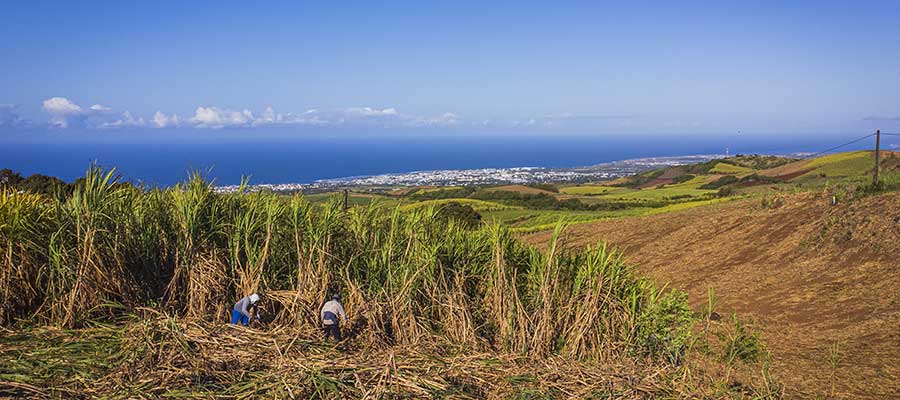Emilie Marty, secretary general of the Réunion des Rhums, explains the reasons for this decline in production and the consequences it may have on the rum industry, the sugar industry, and more broadly on the entire department.
What is the situation of the sugar cane industry in Réunion?
In Réunion, a ‘normal’ harvest is 1.5 million tonnes of sugar cane during the season. But it should be noted that this normality only applies to the past decade. Because 15 or 20 years ago, the target was to reach 2 million tonnes.
In fact, for the past decade, sugar cane production has been declining steadily in Réunion. The last very good year was 2015, with 1.9 million tonnes. In 2019, it was 1.7 million. In 2022, it was 1.133 million, while the critical threshold for the sugar industry to operate is 1.2 million.
And what are the forecasts for 2025?
We don’t have the figures for 2025 yet, but we do have projections. Due to the cyclone at the beginning of the year and last year’s drought, in particular, the forecast at the beginning of the year was 730,000 tonnes of crushed cane. During the sugar cane conference, this figure was revised upwards to 972,000 tonnes, which is still very low.
What are the consequences for the sugar industry?
Factories are operating below their break-even point, since it is technically impossible to transfer cane from one basin (the Gol factory) to another (the Bois-Rouge factory) and vice versa. But that’s not all: industrial equipment is being damaged.
Sugar factories are not designed to process such small quantities of sugar cane; each one is designed to crush 1 million tonnes of cane. Last year, Bois Rouge was shut down for around 30% of the time, whereas it is supposed to operate 24 hours a day during the harvest season.
It means stopping production, restarting it… It’s not good for the equipment, and it causes problems in terms of managing staff who may be furloughed. Not to mention the impact on seasonal workers, staff who are already trained and skilled, who only work when there is activity and therefore cane.
So it has an economic impact on the whole island. All agricultural sectors (livestock, market gardening, fruit, etc.) are organised around the cane industry as the key crop. If it collapses, our entire agricultural model will follow.
And what about rum? How badly has it been affected?
This year is the first time that the industry has sounded the alarm. Things have been difficult for three years now due to the decline in cane and sugar production, which has impacted molasses production.
However, 99% of rum produced in Réunion is traditional sugar cane rum. In previous years, the three large distilleries (Rivière du Mât, Savanna, Isautier) were able to hold out because they could start the season with stored molasses.
But these stocks no longer exist, and they do not know when they will be able to start. Distilleries no longer have sufficient supplies of molasses. To operate properly, 1.5 million tonnes of sugar cane would need to be crushed to produce 55,000 tonnes of molasses. According to the latest projections, it will be difficult to reach 30,000 tonnes.
What would be the direct consequences? In other words, will there be rum at Christmas?
Of course there will be rum at Christmas! Distilleries have decided to supply the local market (Réunion) and the metropolitan market this year, so it is export supplies (Europe) that will be affected by the shortfall in production.
The risk for us is that our export customers will turn to other suppliers that are much larger than us, because it is important to understand that rum is a global market. We are competing with Brazil, India and all the South American countries. However, distilleries have worked hard over the last 15 years to capture new export markets… And all that work is now clearly at risk.
Apart from drought and cyclones, which are linked to climate change, what are the other causes of the decline in production?
Several factors have been identified for a number of years now. Let’s start with the reduction in the number of molecules authorised for growing sugar cane and controlling weeds on farms.
These are decisions taken in Brussels that do not take into account the tropical climate where we are located and where weeds proliferate. There is also the issue of renewing the generation of planters, as more than half are over 50 years old. Cutting cane is also difficult during the harvest season, as it has become extremely difficult to recruit cutters.
More than half of the fields are still cut by hand in Réunion. I understand that we share these factors with the West Indies. Finally, we have a problem with the decline in sugar cane acreage: between 2016 and 2020, we lost an average of 160 hectares of sugar cane land annually, which has been left fallow.
Reunion Island now has 19,000 hectares of land cultivated with cane and around 2,300 sugar cane planters. Our territory produces more than 60% of the cane in the French overseas departments and regions. It is important to remember that this sector remains the backbone of all agriculture in Reunion Island.
We must urgently find solutions to boost production and return to levels that allow all components (sugar cane, sugar, rum and energy) to develop sustainably.

